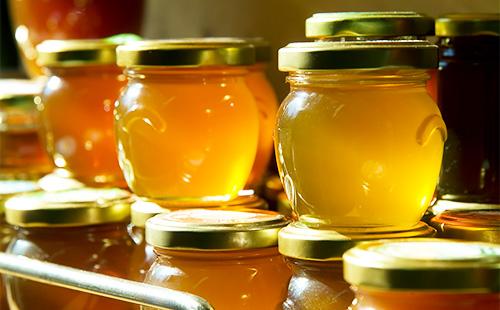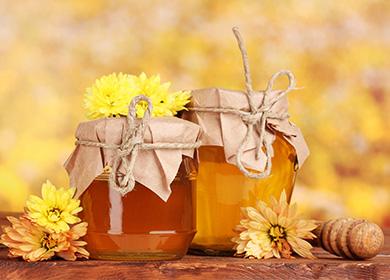The content of the article
According to GOST, honey can be stored in a sealed glass jar or sealed plastic container for no more than two years. Leaking packaging reduces the shelf life of the beekeeping product to eight months. But beekeepers are willing to argue with state standards. They claim that the shelf life of the product is unlimited (with the exception of honey with royal jelly, whose shelf life is only six months). It is only important to create suitable conditions for valuable nectar.
Key conditions
For any product, storage standards are provided. Only with their observance can we talk about high organoleptic qualities and benefits for the body. This also applies to honey. The product is quite “moody”.
Microclimate
If you know at what temperature you need to store honey, this is already half the success on the path to long-term storage of the product without loss of beneficial properties. The experience of beekeepers dictates an optimum temperature of 10 ° C and a humidity of 60%. GOST allows temperature increase up to 20 ° C. To understand why the microclimate is so important, it is enough to study five facts about what happens to nectar when deviating from normal storage conditions:
- temperature below −6 ° C - helps to accelerate the crystallization process. Nectar can become so hard that it will be difficult to get it out of the can with a spoon;
- temperature above + 20 ° C- the beekeeping product loses a significant part of vitamins;
- frequent temperature changes - leads to uneven crystallization;
- low humidity - in a room with dry air, flowering of honey may begin;
- high humidity- may cause fermentation.
Room requirements
In addition to temperature and humidity, there are a number of requirements in which conditions it is better to store honey. The most significant can be considered three points.
- Smells. A container of nectar should not be stored near foods or substances that emit harsh odors. Because of them, the beekeeping product may lose flavoring qualities. This condition does not apply to sealed containers.
- Shine. Keep the container with nectar in a dark place. If the jar will stand for two days in the sunlight, the treat will turn into a sweet dummy that does not bring a person a drop of benefit.
- Ventilation. It is important that the room is well ventilated. If you store nectar in a windowless pantry, leave the door open for several hours daily to allow air circulation.
How to store honey at home: the choice of containers
In some ways, honey can be compared to a sponge.It can come into contact with surfaces and absorb various substances. Therefore, containers in which nectar will be stored should be given special attention.
What can you do ...
In the following dishes, honey can be stored for a long time and not lose their taste and useful properties:
- aluminum can;
- glass jar;
- enameled dishes;
- glazed clay dishes;
- bags and glasses of waxed paper;
- birch barrels.
... and what not
If long-term storage is planned, do not use containers of the following materials:
- iron, zinc, lead;
- plastic containers;
- barrels of coniferous wood, oak or aspen.
How to save a delicacy in honeycombs: 5 rules
For a city dweller, the product of beekeeping in combs is a real exotic. In addition, such a product is much more useful than the usual one from a can, because when you open the signet, the treat instantly loses up to 15% of vitamins. Keeping honey in honeycombs in an apartment is not easy, but it is possible with five rules.
- Humidity level. The normal range of humidity in the rooms is 40-60%. If the indicator rises above this mark, the nectar will turn sour, and if lower, it will grow moldy.
- The optimum temperature. Should be 3-10 ° C. These are ideal conditions under which the product will remain useful for at least a year.
- Neighborhood with fruit. Keep honeycombs away from fresh fruits. They emit a special gas that can lead to spoilage of the beekeeping product. In this regard, bananas are especially dangerous.
- Fragmentation. Judging by the reviews, it is more convenient to store honeycombs if you cut them into fragments. They need to be placed in containers with lids.
- Tightness. It is permissible to store nectar in honeycombs only if they are well sealed. Otherwise, it will leak out and may become sour.

Can crystallization be avoided
The only way to store honey so that it is not sugared is in the comb. The pumped-out product inevitably crystallizes. By creating ideal storage conditions for the treats, you only delay the change in texture. But this is not a cause for frustration. On the contrary, crystallization is a sign of naturalness and high quality. If May honey remains liquid for more than four months, this casts doubt on its quality, naturalness and safety.
The timing of the crystallization of goodies also depends on the variety. For example, linden honey turns into a granular mass a couple of months after pumping. Sunflower, mustard, dandelion and buckwheat honey retains its liquid state for no more than a month. Enough liquid nectar is obtained from clover and acacia. Up to three months, it will remain transparent and fluid. An exception to the rule can be considered products from Ivan-tea and fireweed. When stored properly, they can retain their original physical properties for up to two years.
A real sensation in the scientific world was made by honey found in the tomb of the Egyptian pharaoh Tutankhamun. For more than 3000 years, he has not lost his properties. Nectar was liquid, transparent, had a beautiful floral aroma. Is this not evidence that the shelf life of the beekeeping product is unlimited? It is only important to know how to properly store honey.
Reviews: "... As if just from an apiary"
Our family is very fond of honey, so there are always a couple of jars in stock. I store only in glass containers, in a dark and cool room.I warm it in a water bath if the honey is candied, because it cannot be heated on an open fire, because under the influence of high temperature, honey turns into a carcinogen, and can harm health.
Alyona, http://o-mede.com/kak-hranit-myod.html
Just last week I started a jar of honey - as if just from an apiary. We close the honey in 3 liter glass jars under the metal lids, in general, like ordinary closures.
Miguel https://www.forumhouse.ru/threads/110431/
Honey and at room temperature is well stored, just put it in the kitchen shelf away from light. You can store in the refrigerator, if there is space. It is possible in the basement. The storage temperature of honey can vary from +25 to −10. But it’s better not to bring to −10. The main thing is that the jars in which honey is poured are dry and clean. And you can’t climb into a honey with a wet spoon.
Mirabilis, http://www.lynix.biz/forum/kak-khranit-med

